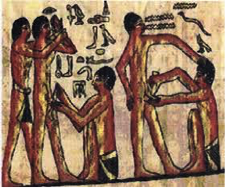 There are two forms of trance; the involuntary which is common, and the voluntary which may be achieved through practice.
There are two forms of trance; the involuntary which is common, and the voluntary which may be achieved through practice.
Such as deliberate induction using a variety of techniques, including prayer, religious rituals, meditation, breathing techniques, physical exercise (tai chi), coitus, music, a form of dancing, fasting, or consuming psychotropic drugs such as cannabis or hash.
Trance in definition is a state of mind which normally occurs involuntarily and bidden. It is a cognitive loop, an object whether it is a thought, sound, an action or an image that repeats itself long enough till it disables a cognitive function in a specific state of mind.
Sleep is a sort of trance, star gazing or daydreaming is another form of trance that falls within the involuntary category.
Historical observation of human behavior notes that there were several traditional techniques practiced to reach voluntary trance state due to its ecstatic nature to human awareness and consciousness.
Some of those techniques were through meditation, ancient magic and the more popular is through prayers.
Trance was regarded to be an altered state of consciousness in ancient philosophy, it is a deeper than ordinary consciousness that is a must in traditional rituals ceremonial practices to achieve any change in reality.
The ancient used meditational trance to heal and improve their wellbeing, while the contemporary uses hypnosis to serve the same purpose by disabling some cognitive functions such as volition, enabling induced suggestions.
Any addiction may be defined as a trance related state of mind, By becoming an addict one seeks to achieve an actual trance in an attempt to escape a certain reality, that is why it is recognized that trance has its effects on our neurological mechanism and (if misused) its psychological implication on us.
We at Paradetect passionately embrace the belief that in applying our concept which is merging spirituality and contemporary life we may be able to create a better and healthier reality enabling us to live in a more peaceful and just world.
We believe there is a great benefit in controlled trance practice. Benefits, such as; healing from an ill entrancement or a possession of any addiction.
Through trance we can achieve an out of body experience and enjoy all of its ecstasy by generating a progressive positive illumining and perceptive mind condition, with an altered consciousness and enhanced suggestibility.
Trance condition may involve the mind, emotions, moods and daydreaming experience filtering information perceived by our senses and by our brain functioning and consciousness enabling us to manage our thoughts and behavior more efficiently.
By trance one may access or induce various modalities such as unconscious mind for relaxation, healing, intuition and inspiration.
Anthropologists and ethnologists found an abundance of historical evidence proving the presence of trance associated disciplines qualifying it to be a derivative to a universal human endemic.
Benefits of trance states are being explored by medical and scientific inquiry. Many traditions and rituals employ trance. Trance also has a function in religion and mystical experience.
I personally am a supporter of the anthropological definition, linking it to an altered state of consciousness.
Mesmer, though discredited, was the original promoter of trance states and their curative benefits. Milton Erickson was the founder of hypnotherapy who in turn introduced trance and hypnosis to orthodox medicine and psychotherapy-hypnosis.
Beta brainwaves (14-21 cycles a second) designate the general state of waking consciousness. It aligns us to a drone-like mindset of the status quo, bringing us to a new awakening reaching to multiple dimensions described by theoretical physicists as a trance state revealing to us an escape hatch from our 3 dimensional realities.
A consciously awake beta state may still be considered as a trance because it involves the selective filtering of information and utilizes cognitive awareness.
Our normal consciousness is a partial segment of our potential consciousness.
The channel used to induce trance is sensory modality ( five senses) usually associated with a belief or mystic tradition often interpreted as supernatural or a contact with a spiritual being, a revelation episode.
Some of the known disciplines applied to reach a trance are: meditation, yoga, Sufism, sleep deprivation, trauma or even a fever.
Rhythmic induction was also used in ancient times to induce trance states throughout the world according to anthropological observation and documentation.
Such practice results in the synchronization of different rhythmic cycles. Breathing and heart rate have been shown to be affected by auditory stimulus, along with brainwave activity. The ability of rhythmic sound to affect human brainwave activity, especially theta brainwaves, is the essence of auditory driving, and is the cause of the altered states of consciousness that it can induce.
The tools to do so are using drums, causing a unison dancing, with simple movements including head nodding, jumping and humming.
Sight is also utilized as a factor in what is known as the photic driving response.
Differing rates of flickering lights affected states of awareness. When light was shined on closed eyelids it resulted in an echoing production of brainwave frequencies. In 1965 Grey employed a stroboscope to project rhythmic light flashes into the eyes at a rate of 10“25 Hz (cycles per second). Grey discovered that this stimulated similar brainwave activity.
Mechanisms and modalities may entrain processes of the brain facilitating rapid and enhanced learning, produce deep relaxation, euphoria, and an increase of creative problem solving propensity and may be associated with enhanced concentration and accelerated learning. The theta range and the border area between alpha and theta has generated considerable research interest.
Trance is psychologically beneficial, by helping to relieve built-up stress, allowing one to reflect on life issues,
Generally, one is only in a theta state for a period of minutes, right before going to sleep, and when waking up. Being in a theta state for 15 minutes is considered to be an “extended period”. With the use of auditory driving, or other meditative techniques, this time can be extended significantly.
Brainwaves are analogous to different types of trance in that they utilize brain and consciousness resources differently and provide different input and information filters.
There are four principal brainwave states that range from high-amplitude, low-frequency delta to low-amplitude, high-frequency beta. These states range from deep dreamless sleep to a state of high arousal. These four brainwave states are common throughout humans. All levels of brainwaves exist in everyone at all times, When a person is in an aroused state and exhibiting a beta brainwave pattern, their brain also exhibits a component of alpha, theta and delta.

Upon waking from a deep sleep in preparation for arising, brainwave frequencies increase through moving from delta to theta and then to alpha and into beta.
Gamma waves
Gamma waves have the highest range of frequencies (around 40 Hz (cycles per second)) and are involved in higher mental activity. They have also been detected during the process of awakening and during active rapid eye movement (REM) sleep.
Beta waves
Beta waves are the most common of the brain wave patterns that occur when awake. These occur during periods of intense concentration, problem solving, and focused analysis. The frequency of beta waves is between 13 and 30 Hz.
Alpha waves
Alpha waves are any of the electrical waves from the parietal and occipital regions of the brain, having frequencies between 8 and 12 Hz. Some scientists consider the range 8-13 Hz and are most usual when we are mentally alert, calm and relaxed, or when day-dreaming. Alpha waves are a sign of relaxation, as they indicate a lack of sensory stimulation in a conscious person.
Theta waves
Theta waves occur when we are mentally drowsy and unfocused, during deep calmness, most daydreaming, relaxation or tranquility, as for example we make the transitions from drowsiness to sleep or from sleep to the waking state. The frequency of theta waves is between 4 and 7 Hz though some researchers regard theta to be 5-8 Hz.
In brainwave frequencies, theta is the frequency range where drowsiness, unconsciousness, dreaming states and deep tranquility happen. Most daydreaming occurs while in the theta range. It is normally a very positive mental state and prolonged states of the theta brainwave frequency while conscious can be extremely productive and a time of very meaningful/creative mental activity.
With practice, meditation can also lower a person’s brainwave frequency to theta while allowing the meditator to remain conscious.
Delta waves
Delta waves occur primarily during deep sleep or states of unconsciousness. The frequency of delta waves is between 0.5 -4 Hz.
Spirituality is a vital tool to help us bring balance into our lives, yet we need to interact and stay in touch with our reality for the sanity of our minds. Thus paradetect concept is the best to serve your purpose.
Stay linked to our website and join in our community by becoming one of our ever increasing membership list.
Adam El Masri






